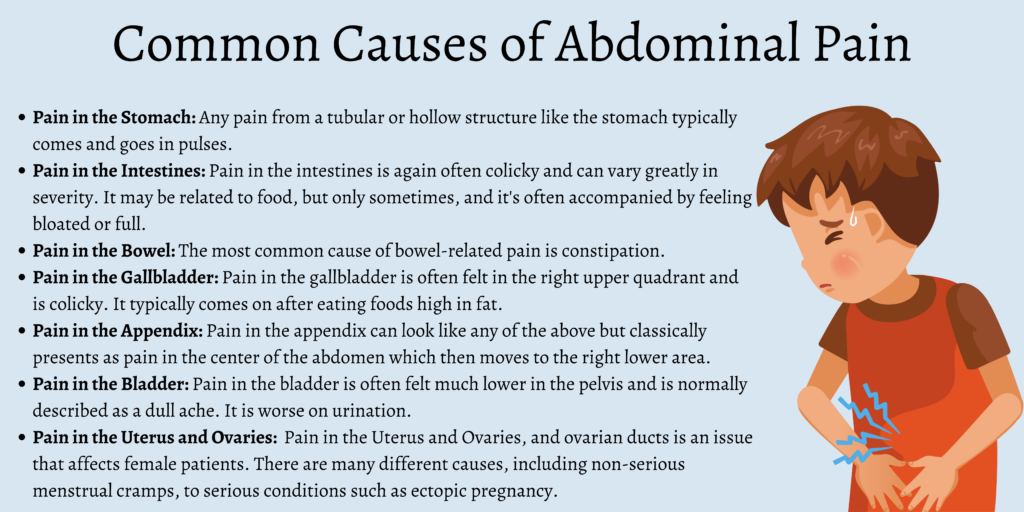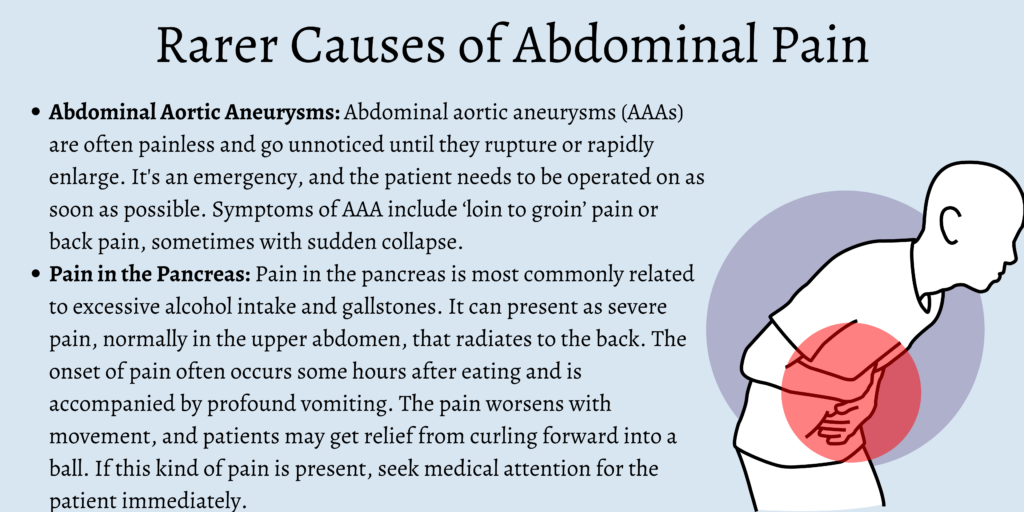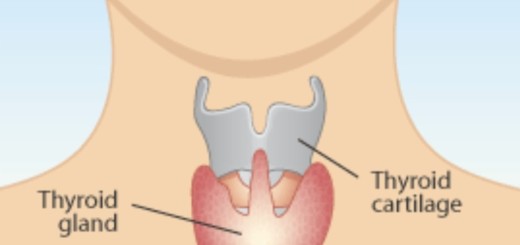First aid for Abdominal Pain
This first-aid guide will discuss a common symptom – abdominal pain! Also known as stomach ache, abdominal pain affects everyone at some point. But the point at which a patient seeks medical attention varies wildly depending on the individual.
As with pain localized to any body part, abdominal pain can be caused by any organ within the abdomen. It includes the stomach, bowels (small and large), gallbladder, liver, spleen, abdominal aorta, bladder, uterus, and pancreas.
Abdominal pain is associated with serious and non-serious medical conditions, with many different causes. And so, without the full picture, first aid for abdominal pain can seem confusing.
Most causes of pain in the abdomen are non-life threatening. But approximately 15% of cases are caused by potentially life-threatening emergencies. So, as a first aider, it’s important to familiarize yourself with some of the causes of abdominal pain to respond appropriately.
Common Causes of Abdominal Pain
Mild abdominal pain can be very difficult to find a cause for. In fact, in around a third of cases, doctors can’t pinpoint the exact reason.
As a first aider, diagnosing a patient is not your job. Anyone suffering from mild abdominal pain should follow up with a healthcare professional if it persists. Suppose there are any signs of shock (tachycardia or low blood pressure). In that case, you must get them to see a healthcare professional urgently.
Pain in the Stomach
Pain in the stomach is often felt in the left upper quadrant of the abdomen. Any pain from a tubular or hollow structure like the stomach typically comes and goes in pulses. It’s often referred to as a colicky type of pain. Stomach pain is often related to food or drink and can be made worse or better by eating. It may also feel like a burning pain, as in heartburn.
Pain in the Intestines
Pain in the intestines is again often colicky and can vary greatly in severity. It may be related to food, but only sometimes, and it’s often accompanied by feeling bloated or full.
Common symptoms which accompany pain in the intestines are diarrhea and vomiting. It may occur either at the time of the pain or in the few days before the onset of pain.
Intestinal pain accompanied by diarrhea and vomiting could indicate an infectious disease. So, when dealing with these patients, wash your hands often with soap and water and keep them separate from others if you can.
Again, suppose there are any signs of shock (tachycardia or low blood pressure). In that case, you must get them to see a healthcare professional urgently. However, if the patient has a normal pulse and blood pressure, they may not need to see a doctor unless the symptoms persist. They will need rehydration, so encourage them to drink lots of oral fluids!
Pain in the Bowel
When did the patient last open their bowels? By far, the most common cause of bowel-related pain is constipation. When hard feces sit in the rectum for a long time, it begins to suck water out of the bowel wall around it. As a result, patients have what looks like loose stools.
Constipation is not usually classed as a medical emergency, and the patient is unlikely to need urgent medical care. Instead, encourage them to drink plenty of fluids and visit their doctor if the problem persists.
Pain in the Gallbladder
Pain in the gallbladder is often felt in the right upper quadrant and is colicky. It typically comes on after eating foods high in fat. It can occur when the gallbladder tries to pump bile into the small intestine, and a stone gets stuck in the bile duct.
This pain is often accompanied by vomiting, which may decrease the pain slightly. The patient may well have had this pain before. In severe cases, the patient may look yellow (jaundice) and present signs and symptoms of shock.
If the patient is shocked, has a temperature, appears yellow, or has uncontrolled pain, send them to the hospital immediately.
Pain in the Appendix
Pain in the appendix can look like any of the above but classically presents as pain in the center of the abdomen which then moves to the right lower area (right iliac region). It could indicate appendicitis.
Other symptoms of appendicitis include:
- Nausea and vomiting
- Fever
- Tachycardia (a rapid heartbeat)
- Constipation, or, less commonly, diarrhea
- Frequent urination
If a patient shows signs of appendicitis, seek professional medical help immediately. If left untreated, appendicitis is a potentially life-threatening emergency.
Pain in the Bladder
Pain in the bladder is often felt much lower in the pelvis and is normally described as a dull ache. It is worse on urination. The patient may urinate more often than normal and complain of urgency (needing to go NOW) and foul-smelling urine.
If pain in the bladder persists, encourage the patient to seek advice from their healthcare provider as soon as possible.
Pain in the Uterus and Ovaries
Pain in the uterus, ovaries, and ovarian ducts is an issue that affects female patients. There are many different causes, including non-serious menstrual cramps, to serious conditions such as ectopic pregnancy.
An ectopic pregnancy occurs when an embryo implants outside the uterus into one of the tubes. Because there isn’t enough space for the embryo to grow, it starts to cause pain. Normally it’s a sharp or dull pain felt in the lower quadrant. However, the pain may spread into the shoulder if bleeding occurs in the abdomen.
Eventually, the embryo runs out of space and ‘pops.’ It’s known as a ruptured ectopic pregnancy. It’s a life-threatening emergency, so if the patient is suspected to be pregnant and presents this type of pain, send them to the hospital immediately.
Rare Causes of Abdominal Pain
Now let’s look at a few less common yet serious causes of abdominal pain.
Abdominal Aortic Aneurysms (AAAs)
Abdominal aortic aneurysms (AAAs) are often painless and go unnoticed until they rupture or rapidly enlarge. It’s an emergency, and the patient needs to be operated on as soon as possible.
Albert Einstein died of an AAA, and he’s certainly not the only one. 50% of ruptured AAA patients die before they reach the hospital. Those who make it to the hospital still face a high chance of a poor outcome. Survivors are often left with a lifelong disabilities.
Symptoms of AAA include ‘loin to groin’ pain or back pain, sometimes with sudden collapse.
If anyone presents with a history of collapse, low blood pressure, loin to the groin or back pain, or a pulsatile abdominal mass, consider an aneurysm and call an ambulance.
AAAs are more common in men over 50 than in younger people or women. Shock may or may not be present. Shock, in this instance, is a very bad sign, and the patient needs urgent medical attention.
Pain in the Pancreas
Pain in the pancreas is most commonly related to excessive alcohol intake and gallstones. It can present as severe pain, normally in the upper abdomen, that radiates to the back. The onset of pain often occurs some hours after eating and is accompanied by profound vomiting.
The pain worsens with movement, and patients may get relief from curling forward into a ball. If this kind of pain is present, seek medical attention for the patient immediately.
How to Treat Abdominal Pain in Adults?
In less serious cases, the patient may not need to seek professional medical attention. Instead, please encourage them to drink plenty of fluids and eat small portions of bland, easy-to-digest food. Over-the-counter pain relievers and antacids may help. A heat pack or a hot water bottle can also provide temporary relief.
If symptoms have persisted for a few days or more, encourage the patient to seek advice from their healthcare practitioner.
More serious cases of stomach pain in adults should be treated immediately by a medical professional. If the following symptoms are present, it’s time to visit a doctor.
- Swelling of the abdomen
- Fever
- Persistent vomiting
- Chest pain
- Very severe pain
- Blood in stools
- Blood in vomit
How to Treat Abdominal Pain in Children And Infants?
Abdominal pain in children and infants is a common complaint with various causes. Most of them are non-serious. However, in some cases, it can be a sign of a life-threatening emergency.
Pain in the center of the abdomen that spreads across more than half of the belly can indicate indigestion, gas, or stomach flu, such as gastroenteritis. Ask the child to describe the location of the pain. In this case, encourage the child to drink plenty of fluids and eat small portions of bland, easy-to-digest foods. Avoid sugar and dairy products. Lying on the stomach can relieve pain caused by gas. In some cases, children may benefit from child-friendly, over-the-counter pain relief.
A more localized pain in a small area can indicate a more serious condition. Suppose any of the following symptoms are present. In that case, seeing a doctor or going to the hospital as soon as possible is important.
- Persistent vomiting
- Diarrhea
- A pale, pallid complexion
- Excessive sweating
- Excessive tiredness
- Loss of appetite
- A localized pain in one area
- Cockily pain
- Pain that lasts more than 24 hours
- Blood in stool
- Skin rashes
- Greenish or yellowish vomit in young children
It’s important to look out for these symptoms in all infants and children. However, for babies and toddlers who cannot yet communicate, pay attention to visual clues too. These include crying, a grimacing facial expression, and lying or sitting with the legs curling up towards the belly.
Conclusion
Abdominal pain is a complex condition with many different potential causes. So, knowing how to provide first aid care can be challenging. Hopefully, this post has helped you recognize some of the signs and symptoms of common and less common causes to help a patient.
Want to learn more about first aid? Why not sign up to one of our FREE online first aid courses







it is important for everyone to be trained first aid.
if i see someone in pain, has a temperature, yellow or the pain is uncontrolled i will send the individual to the hospital